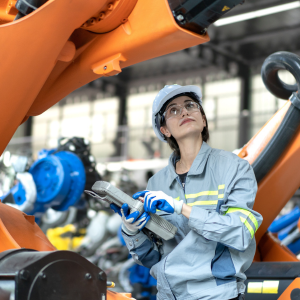Reducing Obsolescence Risk In Manufacturing
Post By: Ryan King On: 09-07-2021 - Industry Trends - Manufacturing
Obsolescence is an accepted part of any life cycle. However, industrial automation equipment is surprisingly durable, and if you installed new machinery in the 1970s, you might still be using it 50 years on. This lifespan is likely to be way past the date set for its obsolescence by the original equipment manufacturer (OEM). Much of your process equipment may therefore be well out of date, so that breakdowns become more frequent, and finding replacement parts more difficult.
The vast changes in technology during this period have also made a lot of equipment obsolete in itself. Manufacturers are looking at ways of reducing the obsolescence risk, or changing over to newer, more efficient and technologically advanced machinery. With many items in industrial automation now being connected to the Industrial Internet of Things, reducing obsolescence risk requires a much greater depth of research to keep up to date with developments.
In the case of software solutions and some automated procedures, it sometimes makes more sense to lease or contract a service for your needs. Business purchasers must therefore carry out stringent research on the OEM of any projected new equipment, taking into account the speed of introduction of new models and the likelihood of their being compatible with existing ones.
You should find out about the continuing availability of obsolete products after a new model appears on the market, and what customer support is offered by the OEM. Users of the equipment can be consulted as to the reliability of the product and its performance, and any ways in which this might be improved to make the equipment last longer. You can also consult maintenance logs and repair teams to assess how often your equipment breaks down, and the average time taken to repair or replace components.
There are a couple of procedures that you can carry out to evaluate your automated system. If you find the idea of so much research somewhat daunting, you might choose to sub-contract these assessments to reduce your obsolescence risk.
Facility Condition Assessment (FCA)
This is an on-site, comprehensive review of your automated industrial system's physical condition, to detect why or where any parts of the application might be worn or failing. Carrying out an FCA will evaluate the whole system's performance, and provide recommendations on what machinery needs to be upgraded or replaced. Such an assessment will allow you to manage and prepare for equipment obsolescence, and budget for its ongoing maintenance, repair and eventual renewal.
Facility Performance Evaluation (FPE)
This is a continuous evaluation of your automated systems. It focuses on reducing obsolescence risk by assessing the functionality, productivity, cost-effectiveness and sustainability of application equipment. It will help you determine the ongoing condition of your equipment, plus the requirement for, and supply of any spares. A database should be created for all parts and components, which must be monitored and regularly updated. Sometimes called a ‘functionality index’, you can use the data provided by an FPE to come up with an obsolescence management plan. This will help you make decisions on whether to upgrade or replace ageing equipment.
Many businesses make these decisions without the benefit of an FCA or FPE, and just opt for more advanced machinery to replace obsolescent equipment. However, this isn't always the best solution. Staff training initiatives can be employed to ensure that industrial equipment is being optimally used and maintained, to prolong the life of its existent components. Predictive maintenance can also help in reducing obsolescence risk, by maintaining and repairing equipment before it breaks down.
Reducing Obsolescence Risks
You may find that you don’t have sufficient resources to allocate a member of staff for the FPE process. In this case, you can help to reduce your obsolescence risk by drawing up a management plan.
This strategy will help you decide what to do when an industrial part reaches its obsolescence date or breaks down:
- Maintain your existing system with repaired or replacement parts
- Upgrade the relevant part, or even the whole system
Before doing this, though, you must first identify what goals you hope to achieve with the obsolescence plan:
- Saving money
- Improving efficiency
- Educating your workforce on reducing obsolescence risk and maintenance
In most cases, a successful plan combines these three goals into a coherent strategy, which must be implemented every day to ensure its effectiveness. Staff should be trained to identify areas of risk and determine the reasons for it, which will also help with budgeting and purchasing. This might require a revision of your company policy to focus on obsolescence management as part of its regular function, and to institute prescribed procedures in response to parts failure.
Without a proper plan to reduce obsolescence risk, you'll be up against greater downtime, a reduction in productivity and possible compliance fines. With an obsolescence management plan, you can reduce your stock holdings, and consequently your risk of the spares themselves becoming obsolete. You can also identify and establish a relationship with a reputable industrial automation supplier, such as Rowse Automation. In this way, you'll have access to the expertise and experience of a supplier who can source and supply the parts you need with the minimum delay, reducing your downtime and ensuring you comply with the relevant regulations.
Comparing The Risks
If you choose to upgrade your equipment with new plant, you'll need to plan carefully to budget for the downtime and upheaval involved in the replacement process. You might also find it much more difficult than you expect to integrate new machinery into your current infrastructure. New technology may not be compatible with older assemblies, and undertaking a retrofit or system expansion could well involve you in expensive adjustments and modifications.
You'll also have to retrain your employees to use the new machinery, as well as any associated software and technological processes that may be involved. If you choose this route, you may well encounter opposition from staff, managers and stakeholders, who have been running comfortably in the same rut for many years and oppose any change.
Furthermore, the regulatory environment has become much stricter since the early days of industrial automation, and older parts might not pass today's compliance tests. These regulations govern many aspects of energy management, power consumption and employee safety, and compliance is obligatory. Inspection and compliance may require a change in working practices and further retraining.
In terms of cost, replacing a failed or broken part with brand new equipment can be vastly more expensive than replacing it with an original component. If you replace your equipment with the same, obsolescent model, it might be second-hand and thus also have a short life cycle. On the other hand, new and unused machinery and parts can be sourced that have been kept in storage since they were produced, and should therefore work just as well as your own original plant.
At Rowse, we have been in business for many years as a reputable industrial automation supplier. As part of our service, we also offer an obsolete product sourcing facility, for any specific items that you need. We are always happy to advise you on which products to choose, on obsolescence management, or any associated issues.
Get More From Rowse Straight To Your Inbox




